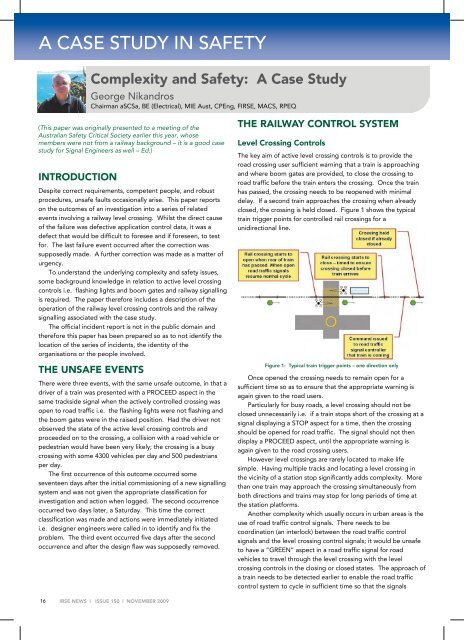IRSE News 150 Nov 09.pdf
IRSE News 150 Nov 09.pdf
IRSE News 150 Nov 09.pdf
You also want an ePaper? Increase the reach of your titles
YUMPU automatically turns print PDFs into web optimized ePapers that Google loves.
A CASE STUDY IN SAFETY<br />
Complexity and Safety: A Case Study<br />
George Nikandros<br />
Chairman aSCSa, BE (Electrical), MIE Aust, CPEng, F<strong>IRSE</strong>, MACS, RPEQ<br />
(This paper was originally presented to a meeting of the<br />
Australian Safety Critical Society earlier this year, whose<br />
members were not from a railway background – it is a good case<br />
study for Signal Engineers as well – Ed.)<br />
INTRODUCTION<br />
Despite correct requirements, competent people, and robust<br />
procedures, unsafe faults occasionally arise. This paper reports<br />
on the outcomes of an investigation into a series of related<br />
events involving a railway level crossing. Whilst the direct cause<br />
of the failure was defective application control data, it was a<br />
defect that would be difficult to foresee and if foreseen, to test<br />
for. The last failure event occurred after the correction was<br />
supposedly made. A further correction was made as a matter of<br />
urgency.<br />
To understand the underlying complexity and safety issues,<br />
some background knowledge in relation to active level crossing<br />
controls i.e. flashing lights and boom gates and railway signalling<br />
is required. The paper therefore includes a description of the<br />
operation of the railway level crossing controls and the railway<br />
signalling associated with the case study.<br />
The official incident report is not in the public domain and<br />
therefore this paper has been prepared so as to not identify the<br />
location of the series of incidents, the identity of the<br />
organisations or the people involved.<br />
THE UNSAFE EVENTS<br />
There were three events, with the same unsafe outcome, in that a<br />
driver of a train was presented with a PROCEED aspect in the<br />
same trackside signal when the actively controlled crossing was<br />
open to road traffic i.e. the flashing lights were not flashing and<br />
the boom gates were in the raised position. Had the driver not<br />
observed the state of the active level crossing controls and<br />
proceeded on to the crossing, a collision with a road vehicle or<br />
pedestrian would have been very likely; the crossing is a busy<br />
crossing with some 4300 vehicles per day and 500 pedestrians<br />
per day.<br />
The first occurrence of this outcome occurred some<br />
seventeen days after the initial commissioning of a new signalling<br />
system and was not given the appropriate classification for<br />
investigation and action when logged. The second occurrence<br />
occurred two days later, a Saturday. This time the correct<br />
classification was made and actions were immediately initiated<br />
i.e. designer engineers were called in to identify and fix the<br />
problem. The third event occurred five days after the second<br />
occurrence and after the design flaw was supposedly removed.<br />
THE RAILWAY CONTROL SYSTEM<br />
Level Crossing Controls<br />
The key aim of active level crossing controls is to provide the<br />
road crossing user sufficient warning that a train is approaching<br />
and where boom gates are provided, to close the crossing to<br />
road traffic before the train enters the crossing. Once the train<br />
has passed, the crossing needs to be reopened with minimal<br />
delay. If a second train approaches the crossing when already<br />
closed, the crossing is held closed. Figure 1 shows the typical<br />
train trigger points for controlled rail crossings for a<br />
unidirectional line.<br />
Figure 1: Typical train trigger points – one direction only<br />
Once opened the crossing needs to remain open for a<br />
sufficient time so as to ensure that the appropriate warning is<br />
again given to the road users.<br />
Particularly for busy roads, a level crossing should not be<br />
closed unnecessarily i.e. if a train stops short of the crossing at a<br />
signal displaying a STOP aspect for a time, then the crossing<br />
should be opened for road traffic. The signal should not then<br />
display a PROCEED aspect, until the appropriate warning is<br />
again given to the road crossing users.<br />
However level crossings are rarely located to make life<br />
simple. Having multiple tracks and locating a level crossing in<br />
the vicinity of a station stop significantly adds complexity. More<br />
than one train may approach the crossing simultaneously from<br />
both directions and trains may stop for long periods of time at<br />
the station platforms.<br />
Another complexity which usually occurs in urban areas is the<br />
use of road traffic control signals. There needs to be<br />
coordination (an interlock) between the road traffic control<br />
signals and the level crossing control signals; it would be unsafe<br />
to have a “GREEN” aspect in a road traffic signal for road<br />
vehicles to travel through the level crossing with the level<br />
crossing controls in the closing or closed states. The approach of<br />
a train needs to be detected earlier to enable the road traffic<br />
control system to cycle in sufficient time so that the signals<br />
16<br />
<strong>IRSE</strong> NEWS | ISSUE <strong>150</strong> | NOVEMBER 2009

















